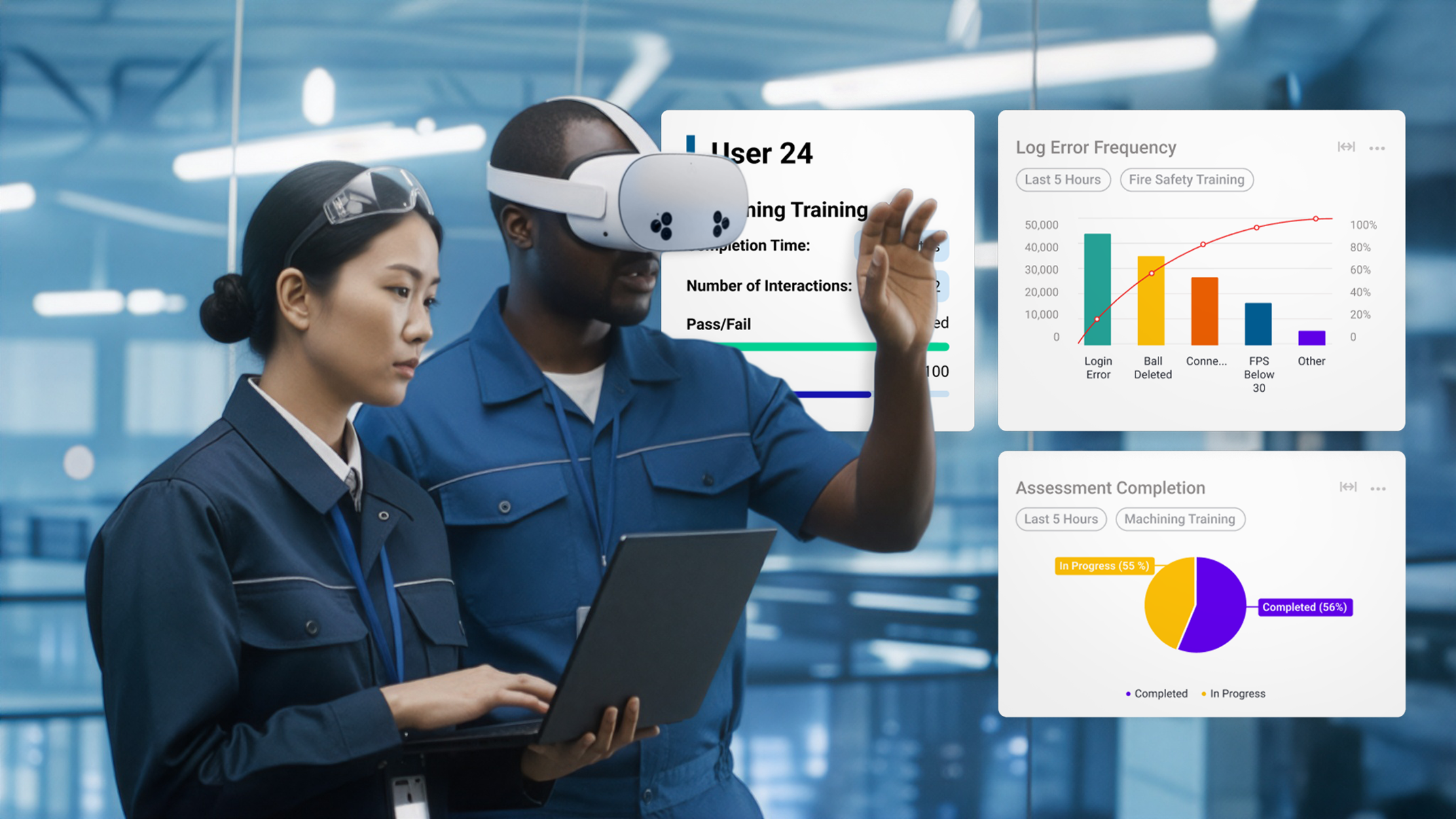Three months into your VR training deployment, the head of L&D walks into your office with a simple question: "Are people actually completing the modules?" You pause. You think your headsets are getting regular use, but who's finishing training? How many tries did it take them? Which tasks are they struggling with most? You realize you're flying completely blind.
Now fast forward a quarter. Budget conversations have stalled. Leadership is asking for "the numbers," and all you’ve got are a few manually tracked completion rates and some glowing comments.. The program that felt inevitable now feels…optional.
XR training programs don't always fail because the content is bad or the hardware is clunky. They fail because once a learner puts on the headset, you lose visibility. You can't see what they did, where they struggled, or whether the experience changed on-the-job performance. Without that visibility, you can't connect training to outcomes or justify expansion.
We're looking at a measurement, not just a tech problem. And until you solve it, XR will remain a cool pilot, not a scalable program.
The irony? XR training consistently outperforms traditional methods in controlled pilots.
By replacing traditional training methods companies like Sanofi achieve $1M in annual operational savings, Mars Wrigley delivered $20M in cost savings over 7 months, and Kellanova saved $1M in a single quarter. The potential is clear: visibility is the missing link.
Below, we'll show why visibility is the missing link between "people liked it" and "this moves the business," and how teams that prioritize visibility from day one escape the pilot trap and earn the budget to scale.
The Visibility Problem

When learners put on a headset, the immersive visuals are powerful, but behind the scenes, most organizations go blind. Without integrated data tracking, you can’t see who completed the training, how they performed, or where they struggled.
Completion rates and surveys only scratch the surface, leaving leaders without the evidence needed to prove impact or justify scaling the program.
Why Visibility Matters
When leadership asks for proof, they're not asking whether people enjoyed the experience.
They want to know:
- Did this reduce workplace accidents or safety incidents?
- Are employees making fewer mistakes on the job?
- How much time did people spend learning vs. struggling?
- Which parts of training do people fail most often?
- Are we training faster than our old methods?
If you can't connect headset activity to workplace performance, you can't answer those questions. And without answers, budgets freeze and momentum dies.
The Measurement Gap
Traditional training methods come with established metrics. You can track who showed up, test scores, hours completed, or certifications earned. In XR, those frameworks don't exist, or they're so fragmented across content vendors that the data is meaningless.
Many organizations aren't even sure what they should be tracking in the first place. Beyond basic completion, there are critical learning indicators most programs miss entirely:
- How many attempts did it take someone to get a task right?
- Where do people get stuck or spend too much time struggling?
- What mistakes are people making most often?
- Who's racing through without actually learning vs. who's taking time to understand?
- Which learners are trying hard but struggling vs. just clicking through?
The lack of a clear playbook for these deeper learning behaviors makes measurement inconsistent, leaving decision-makers skeptical.
The Bottom Line
Without visibility, XR training looks like a black box: learners go in, good feelings come out, but nothing concrete ties the program to business outcomes. And in the world of corporate budgets, "good feelings" don't unlock funding.
The Real-World Consequences of Poor Visibility

When XR training programs lack visibility, the problems show up fast, and they compound over time. What starts as a small gap in measurement quickly becomes the barrier that keeps your program stuck in pilot.
Budgets Stall and Expansion Freezes
If you don't have clear data to prove business impact, XR training becomes an easy target when budgets tighten. Executives hesitate to invest further if they can't see cost savings or performance improvements. Even if learners loved the pilot, leadership won't greenlight expansion without proof.
Sanofi demonstrates the opposite approach. By tracking operational impact, they documented approximately $1M in annual savings through VR training for aseptic lab operations. They could show exact cost reductions, concrete performance improvements, and measurable business impact that justified continued investment.
Leadership Confidence Slips
Every executive has seen the "shiny new thing" before. Without concrete metrics, XR risks being lumped in with failed initiatives that promised more than they delivered. What once looked like an innovative edge starts to feel like a distraction, and internal champions lose the credibility they need to push programs forward.
Koch/Invista faced the same challenge. They overcame it by demonstrating 50-70% reductions in time to proficiency for manufacturing training. These results inspire confidence because they're measurable and scalable, not just anecdotal success stories.
Siloed, Fragmented Data
Most organizations end up over-relying on content vendors for reporting. Each app has its own limited dashboard, leaving you with data silos that can't be compared across programs. If a vendor disappears or you switch providers, you risk losing reporting altogether, along with the institutional knowledge you've built.
Manual Tracking Becomes a Dead End
Some teams try to fill the gaps with spreadsheets, surveys, or one-off developer work. But this is a temporary patch at best. As soon as you scale beyond a handful of headsets or learners, these manual processes collapse under the weight of time, cost, and human error. Instead of driving adoption, the administrative burden becomes a reason to slow down.
One customer achieved a 92.5% reduction in device and content management time (saving approximately $150K annually) by eliminating manual tracking approaches altogether.
The Net Result: Programs Stall
Good pilots never translate into enterprise deployments. Headsets gather dust. Champions burn out. And XR becomes just another promising initiative that failed to cross the finish line.
Kellanova shows what's possible when visibility is done right. They replaced their physical staged grocery store role-plays with VR, saving over $1M in training costs, needing 4x fewer people to run sessions, and boosting upsell success by more than 1,000%. Reps who completed the VR training were 90% more successful at upselling tasks.
The truth is simple: without visibility, XR training programs fail to scale. See additional impact visibility has on XR training here.
How Successful XR Programs Solve the Visibility Problem

The difference between XR programs that stall and those that scale isn't just better hardware or fancier content. It's visibility. Successful organizations treat measurement as a must-have from day one, not an afterthought once leadership starts asking for ROI. Here's how they do it.
Treat Measurement as a Day-One Priority
Pilots should be designed with measurement in mind, not just learner experience. The most successful teams follow a staged approach:
- Adoption: Are people actually finishing the training? How many attempts does it take?
- Impact: Did the training improve job performance, reduce mistakes, or boost confidence?
- ROI: How does it translate into dollars saved or revenue gained?
When you align pilots to this framework, your organization can collect meaningful data early so you're ready to make a business case when expansion time comes.
Create a Unified View of Training Data
Relying on vendor dashboards or fragmented reports keeps you stuck in silos. Winning organizations consolidate training data across modules, teams, and locations into a single system. This unified visibility makes it possible to find gaps and show leaders a complete picture of XR training's impact.
Customers tell us they want to "slice and dice the data" to understand what's working and what isn't across their entire program.
Integrate XR With Business Systems
Training doesn't happen in isolation, and neither should the data. The programs that scale are the ones that connect XR analytics to existing LMS, HR, and BI systems. This allows organizations to show how headset activity correlates with reduced errors, faster onboarding, higher retention, or improved job performance (aka, metrics that leadership actually cares about).
The goal is to "push data to the LMS" and other business systems so XR training data becomes part of existing workflows and reporting structures.
Replace Manual Tracking With Purpose-Built Infrastructure
Manual exports, spreadsheets, and developer workarounds may work for 10 devices, but they collapse under the weight of 100 or 1,000. Scalable programs use purpose-built platforms that automate data collection, standardize metrics, and ensure reporting is reliable.
The Common Thread
An enjoyable learner experience doesn’t mean the program is worth the investment. Successful XR programs prove that the training actually changed behavior and delivered results. And they do it by building visibility into every step of the program. This way, when it's time to scale, the data speaks for itself, helping teams "make the case for scaling."
How ArborXR Insights Solves the Visibility Problem

ArborXR Insights was built to close the visibility gap that keeps XR programs stuck in the pilot phase. Instead of relying on fragmented vendor dashboards or manual spreadsheets, Insights gives organizations a clear, centralized view of what's actually happening inside the headset and how it connects to real business outcomes.
See What Learners Are Really Doing
With Insights, you can finally answer the questions that matter:
- Who finished training, and who gave up partway through?
- How many times did people try a task before getting it right?
- Where did learners spend too much time or get frustrated?
- Which mistakes are happening most often across all learners?
- Who's rushing through without learning vs. taking time to understand?
This gives you visibility into actual learning behavior that helps optimize training and prove effectiveness, not just whether someone launched the app.
Connect Training to Business Outcomes
The insights don't stop at headset activity. It integrates seamlessly with LMS, BI, and HR systems, giving you a direct line between immersive learning and workplace performance. That means you can show leadership how VR training reduced errors, improved safety, or accelerated onboarding with data that ties directly to business impact.
Eliminate Silos and Manual Work
Instead of juggling multiple vendor dashboards or exporting CSV files, Insights consolidates all XR training data into one place. It standardizes reporting across different apps, modules, and cohorts, so you always have a consistent view of performance. And with automated data collection, your team spends less time chasing spreadsheets and more time improving results.
We even make it easy to get that data where it needs to go by integrating seamlessly with your company’s existing BI tools for deeper analysis and reporting.
Scale With Confidence
By giving you visibility from pilot through enterprise rollout, ArborXR Insights transforms XR training into a measurable, repeatable program. You'll know what's working, what isn't, and how to make a case for continued investment.
Don't Let Visibility Be the Reason Your Program Fails

Most XR training programs don't fail because the content is weak or the technology doesn't work. They fail because once the headset goes on, organizations lose visibility. Without clear data, pilots remain feel-good experiments instead of business-critical initiatives.
The programs that scale are the ones that treat visibility as non-negotiable from day one. They show the training improved performance, reduced costs, and drove ROI.
That's exactly what ArborXR Insights makes possible. By turning headset activity into actionable data and eliminating manual tracking, Insights gives you the proof you need to confidently move beyond pilot.
Ready to transform your VR training measurement from pilot-level tracking to enterprise-grade ROI reporting? Learn more about ArborXR Insights and discover how our platform enables organizations to prove the business impact of their VR training programs.
If you're ready to make XR training more than a flashy experiment, now's the time to solve the visibility problem. Schedule a consultation with us today to get started!

